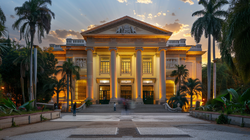National Theatre of Oportia: Difference between revisions
No edit summary |
m (Craitman moved page Théâtre National d'Oportia to National Theatre of Oportia over redirect) |
||
| (4 intermediate revisions by 3 users not shown) | |||
| Line 1: | Line 1: | ||
{{Oportian article}} | {{Oportian article}} | ||
[[File:NationalTheatre1729OPO.png|250px|thumb|right|The Oportian National Theatre in [[Vanie]], [[Oportia]]; {{AN|1728}}.]] | [[File:NationalTheatre1729OPO.png|250px|thumb|right|The Oportian National Theatre in [[Vanie]], [[Oportia]]; {{AN|1728}}.]] | ||
The '''National Theatre of Oportia''' ([[Alexandrian language|Alexandrian]]: ''Théâtre National d' | The '''National Theatre of Oportia''' ([[Alexandrian language|Alexandrian]]: ''Théâtre National d'Oportie'') is the premier performing arts venue in [[Oportia]], located on the [[Avenue de l'Indépendance d'Oportie]] in the capital city of [[Vanie]]. Established in {{AN|1715}} by decree of the [[Federal Representative of Oportia|Federal Representative]] [[Cesar Andre]], the theatre serves as the home of the [[Oportian National Ballet]], the [[Oportian National Opera]], and the [[Oportian National Theatre Company]]. | ||
The neoclassical building, designed by architect [[Jacques-Germain Soufflot]] (who also designed the [[Panthéon National d' | The neoclassical building, designed by architect [[Jacques-Germain Soufflot]] (who also designed the [[Panthéon National d'Oportie|Oportian National Pantheon]]), features an elegant façade with tall, elegant columns and a grand portico. The theatre's main auditorium, known as the Salle des Muses (Hall of the Muses), has a seating capacity of 1,800 and is renowned for its exquisite acoustics and opulent décor, which includes a magnificent crystal chandelier and frescoes depicting scenes from the history of the [[Eura|Euran]] continent, including the famous "[[L'Auto-immolation du Babkha]]" by [[Henri Mansour]]. | ||
The theatre's repertoire encompasses a wide range of classical and contemporary works, including the celebrated Oportian epic ballet "[[La Légende de Norodom]]" and the patriotic opera "[[Le Triomphe de la Liberté]]." The National Theatre also hosts the annual [[Oportian National Theatre Festival]], which showcases the best of Oportian drama, music, and dance, attracting performers and audiences from across the nation and beyond. | The theatre's repertoire encompasses a wide range of classical and contemporary works, including the celebrated Oportian epic ballet "[[La Légende de Norodom]]" and the patriotic opera "[[Le Triomphe de la Liberté]]." The National Theatre also hosts the annual [[Oportian National Theatre Festival]], which showcases the best of Oportian drama, music, and dance, attracting performers and audiences from across the nation and beyond. | ||
| Line 12: | Line 12: | ||
*[[Oportian National Theatre Company]] | *[[Oportian National Theatre Company]] | ||
*[[Oportian National Theatre Festival]] | *[[Oportian National Theatre Festival]] | ||
*[[Avenue de l'Indépendance d' | *[[Avenue de l'Indépendance d'Oportie]] | ||
*[[Vanie]] | *[[Vanie]] | ||
[[Category:Vanie]] | [[Category:Vanie]] | ||
[[Category:Culture of Oportia]] | [[Category:Culture of Oportia]] | ||
[[Category:Theatres and opera houses]] | |||
Latest revision as of 23:42, 15 March 2024
The National Theatre of Oportia (Alexandrian: Théâtre National d'Oportie) is the premier performing arts venue in Oportia, located on the Avenue de l'Indépendance d'Oportie in the capital city of Vanie. Established in 1715 AN by decree of the Federal Representative Cesar Andre, the theatre serves as the home of the Oportian National Ballet, the Oportian National Opera, and the Oportian National Theatre Company.
The neoclassical building, designed by architect Jacques-Germain Soufflot (who also designed the Oportian National Pantheon), features an elegant façade with tall, elegant columns and a grand portico. The theatre's main auditorium, known as the Salle des Muses (Hall of the Muses), has a seating capacity of 1,800 and is renowned for its exquisite acoustics and opulent décor, which includes a magnificent crystal chandelier and frescoes depicting scenes from the history of the Euran continent, including the famous "L'Auto-immolation du Babkha" by Henri Mansour.
The theatre's repertoire encompasses a wide range of classical and contemporary works, including the celebrated Oportian epic ballet "La Légende de Norodom" and the patriotic opera "Le Triomphe de la Liberté." The National Theatre also hosts the annual Oportian National Theatre Festival, which showcases the best of Oportian drama, music, and dance, attracting performers and audiences from across the nation and beyond.
